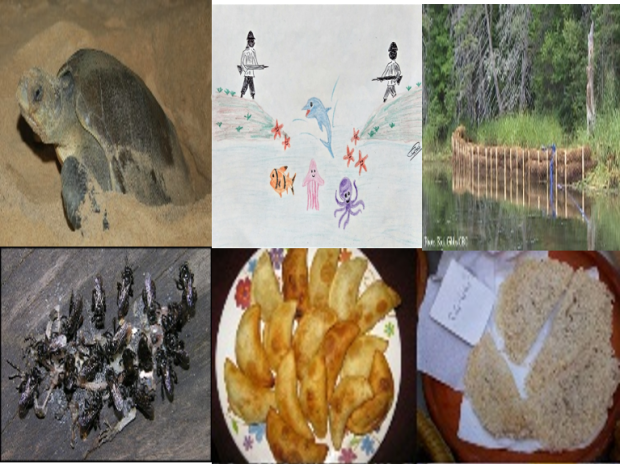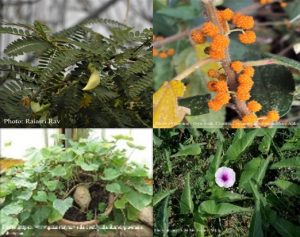Climate worries turtle too….
“Climate change”…….we are really feeling it now. Be it tropical rainforest, temperate boreal forest or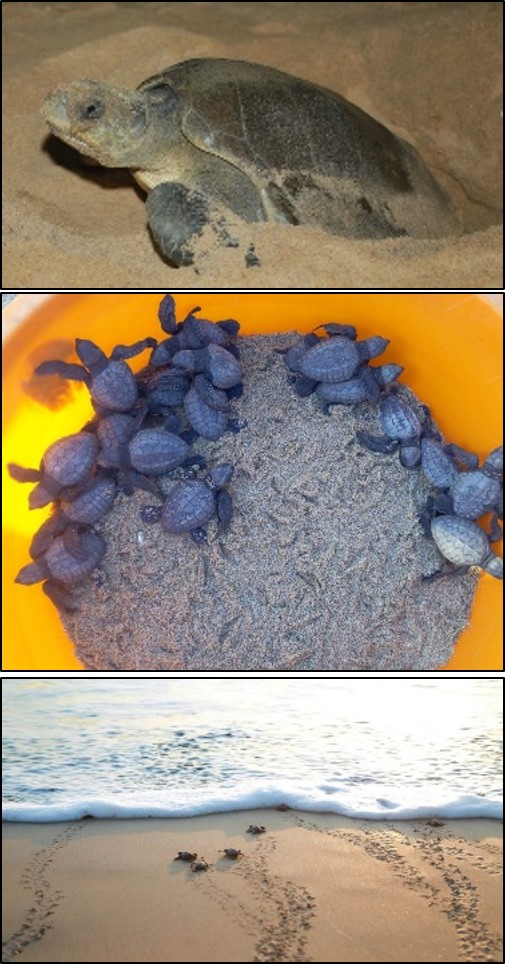 arctic tundra, the sun is getting mightier year after year. Not only we humans, there are reports how plants reciprocate by changing their flowering and fruiting time or their habitats, birds change their nesting habits and migration pattern, even insects are facing the threat of extinction. The list of victims stretches longer day by day and it poses a great challenge to biologists as hitherto unknown behavioral and physiological phenomena are rising up simultaneously. A fascinating example is Olive ridley turtle (Lepidochelys olivacea) – one of the famous yearly visitors of the Indian sea coasts. Every year usually from November onwards, they come in large group to the Indian coast for laying eggs and raising their hatchlings. However, things do not look like the same in recent years A long term observation based on Olive Ridleys of Chavakkad beach, Kerala has detected a considerable shift in breeding season from November – March to January – March. Remarkably, a reduction in incubation period from 45-50 days to 40-42 days has also been observed. Researchers attributed the change to increase sea surface temperature and sand temperature in beach. Also, a gender imbalance, as higher temperature tends to favour female hatchling production, is also noted by researchers. So, at the extreme point we can imagine all female population which is not in an order with natural dynamics.
arctic tundra, the sun is getting mightier year after year. Not only we humans, there are reports how plants reciprocate by changing their flowering and fruiting time or their habitats, birds change their nesting habits and migration pattern, even insects are facing the threat of extinction. The list of victims stretches longer day by day and it poses a great challenge to biologists as hitherto unknown behavioral and physiological phenomena are rising up simultaneously. A fascinating example is Olive ridley turtle (Lepidochelys olivacea) – one of the famous yearly visitors of the Indian sea coasts. Every year usually from November onwards, they come in large group to the Indian coast for laying eggs and raising their hatchlings. However, things do not look like the same in recent years A long term observation based on Olive Ridleys of Chavakkad beach, Kerala has detected a considerable shift in breeding season from November – March to January – March. Remarkably, a reduction in incubation period from 45-50 days to 40-42 days has also been observed. Researchers attributed the change to increase sea surface temperature and sand temperature in beach. Also, a gender imbalance, as higher temperature tends to favour female hatchling production, is also noted by researchers. So, at the extreme point we can imagine all female population which is not in an order with natural dynamics.
Handling the climate dilemma is not an easy task as it often considered at regional or global scale. However, often local actions turn out to be essential, as in case of this species, potential strategies to minimize the heat effect through nest relocation, artificial incubation, and changing the thermal gradient in beach might offer a short-lived solution.
Image and Collector: Sujit Sundaram, N. J. James & Abdul Saleem. Green Habitat, Pavaratty, Thrissur Dst., Kerala, Pin – 680507, India
Guantanamo – prison turns into paradise
The name Guantanamo Bay Prison (or Gitmo) – a majority of people recognize this internationally infamous prison belonging to the U.S.A terrorism and war detainees in no time. This prison covering 120 sq. km of land and water area which the USA has leased at Guantanamo Bay, Cuba. Designated as a naval base and detention camp, the activities are completely related to military strategies, so is not an accessible place for everyone. Amidst the controversy related to the treatment of detainees and sovereignty issues with Cuba, Gitmo was also planned to shut down during President Barack Obama’s tenure to cut off the burden on the Pentagon. Although Gitmo’s future is still uncertain, there are proposals afloat to utilize this detention camp for some constructive purpose.
120 sq. km of land and water area which the USA has leased at Guantanamo Bay, Cuba. Designated as a naval base and detention camp, the activities are completely related to military strategies, so is not an accessible place for everyone. Amidst the controversy related to the treatment of detainees and sovereignty issues with Cuba, Gitmo was also planned to shut down during President Barack Obama’s tenure to cut off the burden on the Pentagon. Although Gitmo’s future is still uncertain, there are proposals afloat to utilize this detention camp for some constructive purpose.
A joint study suggests transforming this facility to a marine conservation centre for unique Caribbean coral reefs, seagrass beds, mangrove forests, and other life forms. The region itself is a paradise for the countless biota owing to Cuba’s’ years of economic and political isolation as well as strong conservation efforts in the last few decades. The study suggests that the strategic location of the camp is perfect for monitoring the marine and terrestrial life forms as well as promoting research. They also suggest a joint operation by the USA and Cuba to ease the strained relationship for a better ecological future of the region.
Source: J. Roman, J. Kraska. Reboot Gitmo for U.S.-Cuba research diplomacy. Science, 2016; 351 (6279): 1258 DOI:10.1126/science.aad4247
Image: Rajasri Ray
Collector: Rajasri Ray
Coconut at the coast….by all means
Coconut tree and coast are synonymous for us. This lofty monocot standing near the seashore is a visual relief for tired seafarers, a phenomenal example of water-based seed dispersal and plant migration, livelihood resource for coastal people, and a potential blocker for seashore erosion nowadays. Seashore erosion is a global problem and conventional remedial measures like seawall and groyne construction, sea dykes, revetments have drawbacks like high cost and environmental damage. Coconut tree, a suitable alternative, remain instrumental as soft measures of coastal erosion protection. Coastal bioengineering project in the USA has applied coconut husk (also known as coir) to make natural fibre blankets and coir rolls to prevent coastal erosion and maintain habitat and ecosystem function for coastal-adapted species. Blankets are mat-like structures where coirs are loosely woven or sometimes are stitched together with other bio-degradable materials. Coir rolls are cylindrical structures very different from blankets and nicely are packed with fibre and tied with netting, in some instance, coir fabrics with the sand-filled interior known as coir envelope are also made. These protective structures are often dotted with saplings of soil binding species so that mature plants can replace their protective functions when the main framework eventually wears out. The main advantages of using coconut are its abundance, easy to use, cost-effectiveness and acceptability. A recent example of its application can be seen at Karangjaladri village of Pangandaran Regency of Indonesia, south-east Asia. Scientists of Bandung Institute of Technology along with local villagers installed a 20-meter-long coconut husk sea-wall to arrest the loss of land near the village. Multiple coconut coir rolls were stacked and dotted with saplings of local species to prevent the coastal erosion in the long run. So, coconut at the seashore is deeply desired by all means.
migration, livelihood resource for coastal people, and a potential blocker for seashore erosion nowadays. Seashore erosion is a global problem and conventional remedial measures like seawall and groyne construction, sea dykes, revetments have drawbacks like high cost and environmental damage. Coconut tree, a suitable alternative, remain instrumental as soft measures of coastal erosion protection. Coastal bioengineering project in the USA has applied coconut husk (also known as coir) to make natural fibre blankets and coir rolls to prevent coastal erosion and maintain habitat and ecosystem function for coastal-adapted species. Blankets are mat-like structures where coirs are loosely woven or sometimes are stitched together with other bio-degradable materials. Coir rolls are cylindrical structures very different from blankets and nicely are packed with fibre and tied with netting, in some instance, coir fabrics with the sand-filled interior known as coir envelope are also made. These protective structures are often dotted with saplings of soil binding species so that mature plants can replace their protective functions when the main framework eventually wears out. The main advantages of using coconut are its abundance, easy to use, cost-effectiveness and acceptability. A recent example of its application can be seen at Karangjaladri village of Pangandaran Regency of Indonesia, south-east Asia. Scientists of Bandung Institute of Technology along with local villagers installed a 20-meter-long coconut husk sea-wall to arrest the loss of land near the village. Multiple coconut coir rolls were stacked and dotted with saplings of local species to prevent the coastal erosion in the long run. So, coconut at the seashore is deeply desired by all means.
Source: https://climateactiontool.org/content/restore-natural-coastal-buffers-bioengineering-coastal-banks
https://theconversation.com/we-built-environmentally-friendly-sea-walls-from-coconut-husk-heres-what-we-learned-122725
Image: Rick Gibbs, Susanna Nurdjaman
Collector: Rajasri Ray
Honey, I want to eat you up !!!
The taste of flesh is fancied by many of us. But wait, we have a like-minded companion in the bee world too! Vulture bees are the only carnivorous, obligate necrophagus bees reported to date which use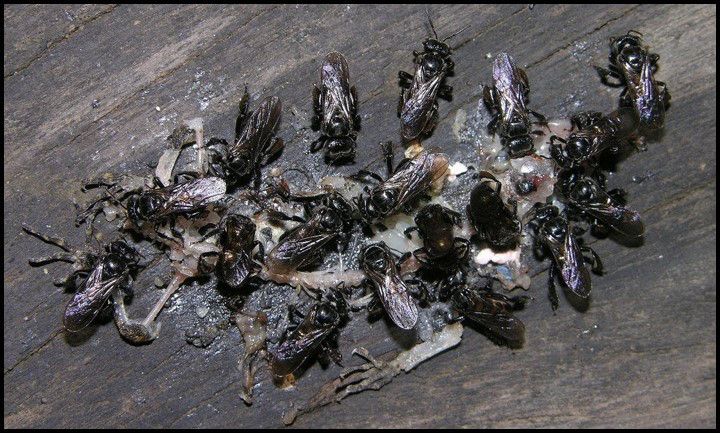 carrion as their sole protein source. They own extremely sharp jaws which aids them to tear apart their meal. These scavenger, stingless, eusocial bees of genus Trigona, primarily three representatives T. hypogea, T. necrophaga and T. crassipes, are the only known bees which do not rely on plants as food source. The worker bees masticate the carrion, secret saliva or mandibular secretion (honey-like concoction of fruit juices) on the flesh to hydrolyze and consume it. On returning to the hive, this meat slurry is regurgitated and processed by other worker bees with their own unique digestive enzymes breaking it down into a decay-resistant glandular substance. This meat-mead mixture is then stocked in honeypots and used to feed the hive population over long periods. These bees have completely forsaken pollen gathering – the workers don’t own pollen combs on their legs. However, it is advised not to collect this honey as vulture bees store only required amount of it to sustain their hives, unlike common honeybees who are abundant producers.
carrion as their sole protein source. They own extremely sharp jaws which aids them to tear apart their meal. These scavenger, stingless, eusocial bees of genus Trigona, primarily three representatives T. hypogea, T. necrophaga and T. crassipes, are the only known bees which do not rely on plants as food source. The worker bees masticate the carrion, secret saliva or mandibular secretion (honey-like concoction of fruit juices) on the flesh to hydrolyze and consume it. On returning to the hive, this meat slurry is regurgitated and processed by other worker bees with their own unique digestive enzymes breaking it down into a decay-resistant glandular substance. This meat-mead mixture is then stocked in honeypots and used to feed the hive population over long periods. These bees have completely forsaken pollen gathering – the workers don’t own pollen combs on their legs. However, it is advised not to collect this honey as vulture bees store only required amount of it to sustain their hives, unlike common honeybees who are abundant producers.
Source: reddit.com, Roubik DW 1982
Collector: Debarati Chakraborty
Sticky rice of extended Bengal
Divisive politics may alienate various human societies and cultures, but we often stand united owing to our shared cultural history that is quite resistant to erosion. The same holds true for the large rice-eating populations of Assam, Bangladesh, Tripura, and West Bengal, so much so that rice has been assimilated in various forms, shades and tastes. Thus, our food culture is tied with rice, from staples to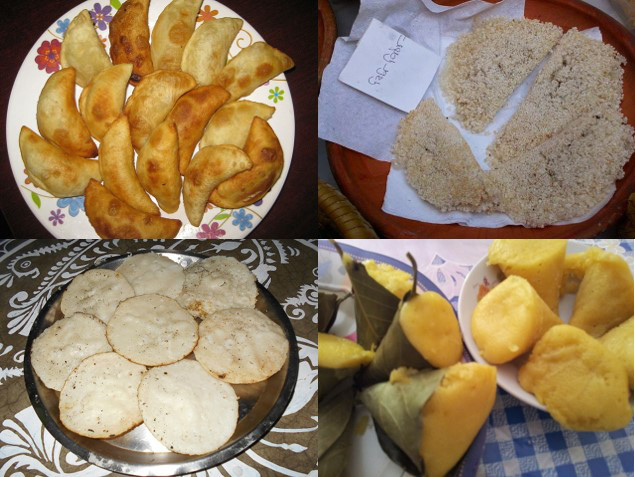 appetizers, snacks to sweets, savories to desserts, so on. One such case is sticky rice, though sticky or waxy rice has not been a mainstay of south Asian food generally it catered various delicacies to tickling tongues of this vast region.
appetizers, snacks to sweets, savories to desserts, so on. One such case is sticky rice, though sticky or waxy rice has not been a mainstay of south Asian food generally it catered various delicacies to tickling tongues of this vast region.
In Assam, the commonly used landrace of sticky rice is Bora Saul (bora means sticky), it is generally soaked, ground, and mixed with jaggery and milk to prepare various kinds of pitha (traditional sweet dish) in Assam mostly during their state festival Bihu. In Assam and also the neighboring country, Bangladesh, sticky rice also finds great use in breakfast and ceremonial dishes, comes in various avatars, where it is known as Beruin chaal (which also means sticky rice). This is quite a to-die-for rice and in great demand which farmers used to fulfill growing this rice prior to special occasions with proper care. Binni dhan (unhusked sticky rice) is another kind of sticky rice equally popular among Bangladeshis is mostly cultivated hilly tracts of Garo Pahar in Jamalpur district. The Binni is also locally appreciated to prepare rice bubbles or puffed rice (Muri / Khoi).
However, the fame and appreciation of Binni or Beruin or pitha had easily eluded borders and diffused all through into locales of Assam and Bengal alike owing to their long entwined socio-political and cultural history through the ages. Sniffing through nooks and corners of extended Bengal may also reveal striking similarities which compels us to satiate our hunger and appreciate the great diversity of food and culture.
Image courtesy: (clockwise) Wikipaedia: Ibrahim Husain Meraj – Own work, CC BY-SA 3.0, https://commons.wikimedia.org/w/index.php?curid=30198301; Omarshehab – Own work, CC BY 2.5, https://commons.wikimedia.org/w/index.php?curid=3863512; কাঠপিপঁড়ে – Own work, CC BY-SA 4.0, https://commons.wikimedia.org/w/index.php?curid=65979003; Mohowrites – Own work, CC BY-SA 4.0, https://commons.wikimedia.org/w/index.php?curid=49295365
Collector: Avik Ray

